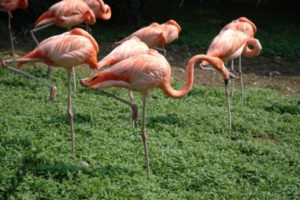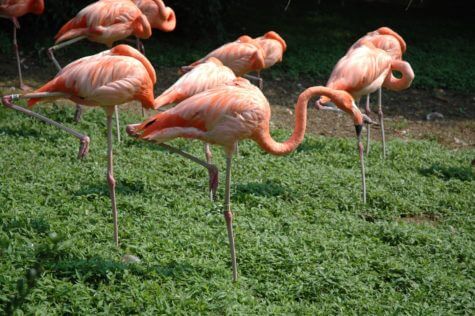ATLANTA — Stop off at the flamingo exhibit at your local zoo and there’s a good chance you’ll come upon one of the seemingly carefree hot pink birds dozing off while balancing on one leg. Flamingos are commonly seen perched in this pose, but the exact reason as to why hasn’t been known — until now.
Previous research led many to believe that the flamingo uses the position as a means to reduce muscular effort. A new study finds, however, that flamingos actually stand on one leg — why else? To relax.
Researchers at Emory University studied the Chilean flamingos residing at the Zoo Atlanta, along with two flamingo cadavers and flamingo skeletons.

The team found that a “passively engaged gravitational stay apparatus” kept the birds balanced, and that a flamingo’s unique anatomy allows it to maintain the position without locking bones or requiring no muscle use. For flamingos, standing on one leg is akin to enjoying a rest on a hammock, the researchers determined, a trait exclusive to the flamingo.
“The biomechanics are such that when they stand on one leg, they become very stable and are able to maintain that posture without activating muscle,” says Lena Ting, a professor of biomedical engineering and rehabilitation medicine and study co-author, in a university news release. “If they deviate from that posture to two legs, that no longer holds. It’s very posture-specific, a one-legged posture that can support their body weight.”
The researchers also found one of the most important discoveries by examining the cadavers. Co-author Young-Hui Chang, a professor of biological sciences at the Georgia Institute of Technology, said their hunch that the birds use the position to relax was confirmed when he positioned one of the dead flamingos into the one-legged stance. What happened next was stunning — the flamingo still “stood” in the pose.
“I don’t know what made me do it, but I just kind of grabbed the leg and picked it up,” he says. “Here we have a non-living animal able to stand on one leg. Obviously, if it’s not alive, then the muscles are not activated.”
Part of the bird’s unique structure includes its ankle in the middle of its leg — the feature that appears to be a “joint” is not a knee, as many observers believe.
“Most people don’t realize that knee and hip joints are not actually in view in most birds,” says Chang. “They’re near the body, kind of behind the wing. The flamingo thigh is almost perfectly horizontal.”
It’s just one of the features that helps the flamingo maintain the odd stance with ease while being able to escape quickly should a predator be on the prowl.
As for how the study can be beneficial for future research, Chang and Ting believe that the flamingo’s anatomy could perhaps lead to more use prosthetics and other supportive devices that could aid disabled humans. They even believe the findings could be useful in robotics.
“If we know how much is passive mechanics and how much the nervous system has to control, it puts researchers in a better position to treat people,” says Chang. “If you design the biomechanics of a robot in the right way, not so much sensing but a sort of feedback control, then they would have this passive ability, and they would be more robust in uncertain environments.”
The study’s findings were published this month in the journal Biology Letters. Officials from Zoo Atlanta monitored the study to ensure no live birds were harmed for the research.
